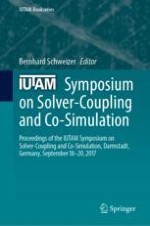This is the Proceedings of the IUTAM Symposium on Solver Coupling and Co-Simulation that was held in Darmstadt, Germany, September 18-20, 2017. The symposium focused on recent advances in the development of numerical methods for solver coupling, like new explicit, implicit and semi-implicit co-simulation methods, new approaches for realizing variable communication-time grids, and advances in the stability and convergence analysis of solver coupling methods.
Recent developments in the practical application of co-simulation methods, for instance new fields of application for solver coupling approaches, new developments in the parallelization of dynamic models with co-simulation techniques, and standardization of co-simulation interfaces, i.e. standardization of data and model exchange were also discussed.
The book brings together the research results of leading scientists in applied mathematics, mechanics, and engineering science, thus contributing to further develop numerical methods for coupled simulations.
